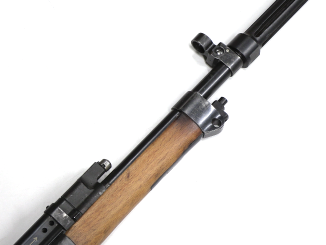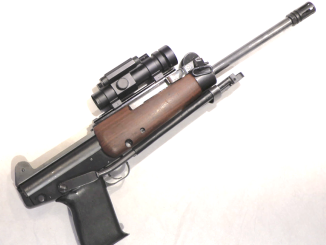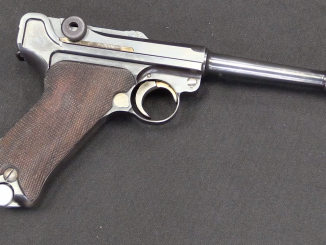Order your copy of Small Arms of the Cold War: Battle Rifles of NATO today:
https://www.headstamppublishing.com/cold-war-battle
Or if you are in Europe, please order through our European site:
https://www.headstampbook.com/cold-war-battle
When Sweden decided to replace its bolt action Mausers and Ljungman semiautomatic in the 1960s, it had four main choices to pick from. One was the domestic GRAM-63, a modernized version of the Ljungman, the FAL and the G3. They ended up choosing the G3, but not without a number of changes.
Mechanically, the Swedes insisted on a longer service lifespan of the rifle than H&K rated it for. To this end, the Swedish model got a heavier recoil buffer, extending its like to 15,000 rounds. There were also changes to the stock, sights, bayonet attachment, and bolt carrier as well as the use of a clip-on rubber case deflector.
The initial batch of Swedish AK4 rifles was purchased directly from H&K, while domestic licensed production was set up at (eventually) both the star-owned Carl Gustaf factory and also the Husqvarna company.
Thanks to the Supply Battalion of the Estonian Defense Forces Support Command for giving me access to film this surprisingly hard-to-find rifle!




The large difference in expected service life comes as a surprise to me. 6000 rounds doesn’t really sound, under these circumstances, like very much shooting.
How does this compare with the expectations for most other national armies for their primary battle rifles?
I’ll bet this information can be found in a certain new book that is recently available. I wish I had a copy, wink wink!!
CG
“(…)compare with the expectations for most other national armies for their primary battle rifles?”
According to https://guns.fandom.com/wiki/FN_FAL
…original FAL receivers were forged and milled with a projected lifespan of 80,000 rounds. Blake Stevens (personal communication) has observed one of these receivers which cracked in the locking-lug area after 60,000 rounds. Stevens has also seen a Canadian army FAL receiver (manufactured by flame cutting on a pantograph machine) which cracked after 40,000 rounds…
Even lowest of values given is orderofmagnitude greater than 6000.
The subject of service life has to be examined in the context of what the basic operating philosophy was for the military doing the procurement.
If you were expecting cheap and cheerful service lives for the guns, in the hands of conscripts who’d basically only be expected to live a few hours in combat, you went with the cheapest thing you could imagine, and specced out durability and service lives that barely met those expectations.
If, on the other hand, your model of military service meant that you’d be issuing those rifles to long-service conscripts that were basically trained to professional-army standards and expected to keep their weapons with them for the duration of their service? Well, those armies procured on a different standard.
Swiss rifles were expected to go home with the trained soldier and stay there, awaiting service and doing periodic mandatory marksmanship training. Which is why the Swiss military rifles were what they were: Heavy, over-engineered, and built to last. And, last…
If you examine some of the other armies in Europe, they foresaw their rifles being used in training, and then only issued from arsenals when the call-ups happened. Different philosophy, different designs…
The Swedes and a couple of others, like the Finns, have a model that’s in between say, the Swiss and the French. As such, they needed a bit more durability and service life than the Germans or French did, and that’s why they tweaked the designs the way they did.
I’m going to be very interested in observing how the Sako rifles they’re buying now wind up lasting. My personal opinion on the design they’re based on, the M16, is that the design is “good enough” for around 20-40,000 rounds, but then it’s done for. A lot depends on rate of fire and how badly it gets abused; some M16 rifles that I’ve seen are toast with under 10,000 rounds through them, and others seemingly go on and on and on, forever… You just have to keep swapping wear parts.
I would have really liked to see someone do a real longitudinal research study on wear and all of that, during the conflicts in Iraq and Afghanistan. That would have required a little too much in forethought and consideration, however. The US military would never have done it, even though they might have learned a good deal of interest.
excellent summary, many thanks
cg
Interesting to note that same rifle in different caliber had vastly different life expectancy – claimed lifetime of 7.62×39 version of G3 offered to Yugoslavia and tested here in 1962. was claimed to be 18000 rounds. This was higher than vz.58 (12000) and 7.62×39 AR-10 (15000). There is no figure for AK since those were “illegally” obtained and hence there was no option to ask manufacturer. 🙂
IIRC FAL (7.62×51 version, FN did not finish 7.62×39 version in time for testing) was claimed to be good for 10000 rounds. Ironically, while that would possibly give potential 7.62×39 version highest life expectancy FAL was actually only rifle disqualified from testing due the numerous jamming issues during harsh condition testing and part breakages during endurance testing.
If it was the standard G3 only adapted to 7.62X39, it’s hardly surprising. That beast would have weighted almost 1.5kg more than a vz.58.
Careful. If you say ‘battle rifle’ here there are rancorourancorous here who wash your mouth out with cordite.
“(…)star-owned Carl Gustaf(…)”
What made said entity star-owned?
The buffer is duel purpose. Its also a deflector and was intended to prevent wrong handed conscripts/soldiers from getting hit buy an occasional high velocity case. They cause the pattern forward and generally in the same location. Anyone who has shot these rifles know empties are launched into the next zip code with authority.
That’s an understatement… I know a guy whose German Army conscription came to an early and inglorious end because his buddy opened fire with a G3 and he got his left eye taken out by one of the ejected cases. He was a couple of meters away, and apparently in exactly the wrong position for it to happen.
They did give him a nice government job, afterwards.
Funny thing is, when they were telling me the story, I thought he was saying he lost his eye from a brass case fragment or something from a bullet/ricochet… Nope; ejected brass. Apparently, there were supposed to be a bunch of safety briefs and precautions on that live-fire range, and a bunch of cadre-level NCOs got into trouble because the warnings weren’t given and the precautions weren’t taken.
So, yeah… Brass from any of the old roller-locked HK weapons are notorious for damn near being secondary projectiles, and a general threat to life safety and health.
Always thought the did that to keep the enemy from creeping up on you from the right.
I was surprised by the remark regarding alleged lack of service life of the German G3, too.
Bundeswehr G3s underwent, dependent on condition, a regular factory recondition program. E.C. Ezell in Small Arms Today (Stackpole 1984) p. 89 shows a G3 that had been reconditioned by HK in March 1963, November 1969, March 1975, July 1980 and May 1983, each done by HK.
This number of reconditions is very high, but during my service I encountered a number of G3s which showed one or two reconditioning markings (right side of magazine guide).
What I was told when I asked about the number of rebuild stamps on a G3 (which was three) was that the Bundeswehr basically kept several fleets of guns going, and that they’d never switch any out between them… The rifles in the “unit fleet” got the ever-loving snot shot out of them, and were constantly going back to depot; the ones out in the storage sites for the reserve units and so forth were never used, and only got rebuilds when there were mandatory modifications that had to be made. If a rifle was assigned to a unit that constantly churned through training conscripts (which was most of the “active” Bundeswehr), then that could mean as little as two or three years between rebuilds. There were also some other things that might trigger a rebuild, like a unit getting shut down and then all the weapons getting automatically rebuilt.
I want to say that there was some limit, but the conversation where this was discussed was not in perfect English or German; I think the gentleman I was talking to was saying that so long as the receiver was in spec or could be made to be in specification, then the weapon would be rebuilt. In the mid-1980s, he said that the most he’d ever seen a specific rifle go through the process successfully was four times…
YMMV… This was related to me on a freezing range while we waited for people to shoot, and it was conducted in pidgin German/English that was less than ideal for accurate transferal of information.